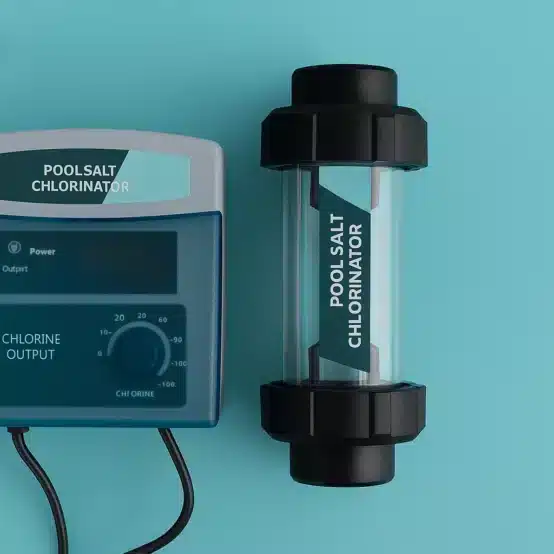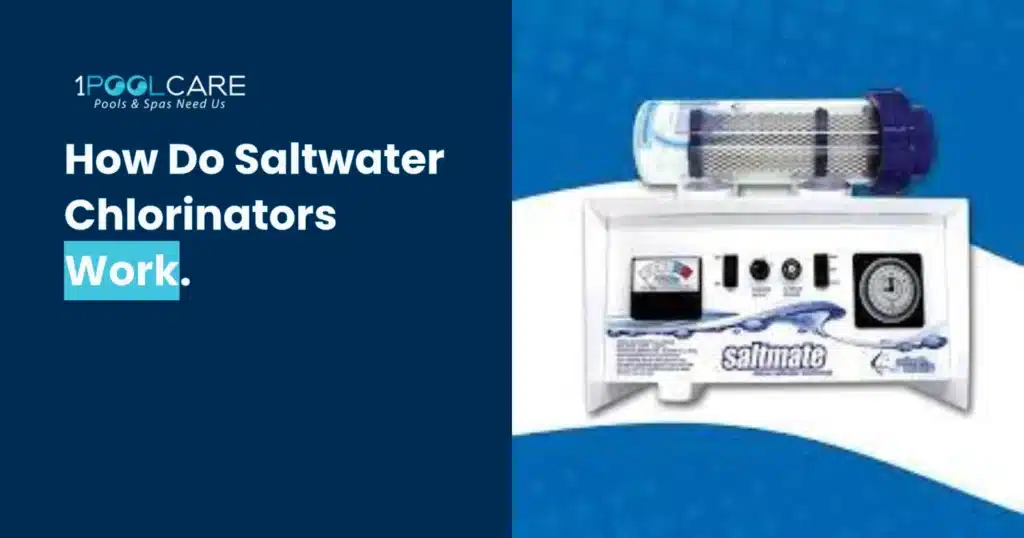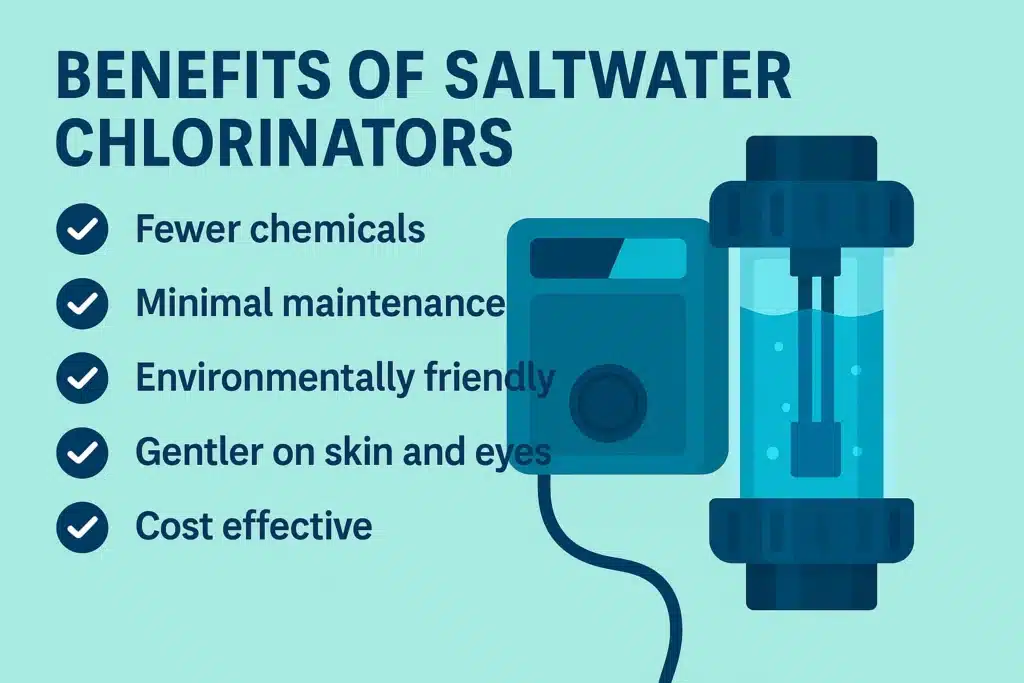If you are new to saltwater pools, you may be wondering what a chlorinator actually does. Unlike traditional pools where you need to manually add chlorine, saltwater chlorinators simplify pool maintenance by generating chlorine on-site through a chemical process. In this guide, we will explain exactly how saltwater chlorinators work, why they are preferred in saltwater pools, and how they help you maintain a clean and healthy swimming environment with minimal effort.
What Is a Pool Chlorinator?
A pool chlorinator is a device used to sanitise swimming pools by producing and dispersing chlorine. In saltwater systems, these units are known as salt chlorinators or saltwater pool chlorinators. They do not require you to pour liquid chlorine into your pool water. Instead, they use a chemical process called electrolysis to create chlorine directly from dissolved salt. Salt chlorinators typically require a salt concentration of 3,000 to 5,000 ppm for effective operation.
So, what is a chlorinator? It is an automated system designed to keep your pool sanitised without the strong chlorine odour, harsh chemical side effects, or need for daily monitoring. Saltwater chlorinators help eliminate harsh chemical doors present in conventional chlorinated pools.
How Do Saltwater Chlorinators Work?
Saltwater chlorinators operate through a process called electrolysis. This happens when your filtration pump pushes water through a salt cell, also known as an electrolytic cell, located in the plumbing line. As the saltwater flows through the cell, a small electrical current converts dissolved chloride ions from sodium chloride (salt) into chlorine gas.
The chlorine gas then dissolves in the pool water and forms hypochlorous acid, a powerful sanitiser that destroys bacteria, viruses, and algae. The key benefit is that the system produces chlorine continuously while the pump is running, which ensures steady levels of sanitiser in your pool.
These systems are often referred to as swimming pool chlorine generators or chlorine generators.
What Does a Chlorinator Do for a Pool?
A saltwater chlorinator does much more than just add chlorine. It keeps your pool functional and safe by:
- Maintaining consistent chlorine output
- Reducing fluctuations in chemical levels
- Removing contaminants without introducing harsh chemical odours
- Ensuring the water remains balanced without the constant need to add extra chemicals
Since saltwater chlorinators work automatically, they improve the overall quality of your swimming pools with less effort and fewer adjustments.
Should My Chlorinator Be Full of Water?
Yes, your chlorinator should be full of water when the system is running. The presence of water is essential for the electrolytic process to occur. Without sufficient flow, the salt cell cannot generate chlorine, and it may even suffer from excessive wear.
Some advanced units include smart features that detect low flow or cold water conditions. These systems adjust chlorine output remotely through a control board to prevent damage and maintain performance.
What Is a Self Chlorinating Pool System?
A self chlorinating pool system is a modern pool setup where the chlorinator automates the sanitisation process. Once installed and configured, these systems work independently by generating their own chlorine from the salt in the water.
Many of these systems now feature Bluetooth or WIFI connectivity. This means you can control the settings through a remote or mobile device, making adjustments without being physically present at the pool. The new generation of chlorinators offers Bluetooth or WIFI connectivity that allows you to monitor and control your chlorine output remotely.
Some models also integrate with broader pool automation systems, enabling streamlined management of your pool’s cleaning, heating, and chlorination cycles.
Benefits of Saltwater Chlorinators
Switching to a saltwater pool system offers several benefits:
- Fewer chemicals: Salt systems reduce reliance on bottled chlorine and additional sanitising chemicals
- Minimal maintenance: A chlorinator requires minimal maintenance when installed properly
- Environmentally friendly: Produces fewer waste chemicals and emissions
- Gentler on skin and eyes: Saltwater is softer than traditional pool water and avoids irritation. The salt in saltwater pools is present at levels lower than that of seawater, making it gentle on the skin.
- Cost effective: Though the initial investment is higher, long-term costs for chemicals and upkeep are lower
Do Saltwater Pools Still Require Maintenance?
Yes, while salt chlorinators automate chlorine production, routine care is still important. You should still:
- Conduct regular water testing to monitor pH, free available chlorine, and stabiliser levels like cyanuric acid. Regular water testing is still needed to maintain proper chemical balance in the pool.
- Check salt levels, which should generally stay between 3,000 to 5,000 ppm
- Clean the salt cell periodically to remove scale buildup
- Inspect the control board and system alerts
- Schedule professional servicing every year
Also, in some cases, you may still need to supplement with additional standard pool chlorine after heavy rainfall or pool parties.
Understanding the Chlorine Generation Process
The process of electrolysis starts when the filtration pump turns on and circulates water through the salt cell. Inside, dissolved salt breaks down into sodium and chloride ions. The electrolytic cell applies a current that converts the chloride ions into chlorine gas.
Once in the water, the gas combines with hydrogen and oxygen to form hypochlorous acid, which sanitises the water. This process:
- Happens only when the pool circulation system is running
- Produces chlorine gradually and evenly
- Does not require stabilisers or balancing chemicals
- Allows salt to be recycled within the system, reducing the need to frequently add more salt to the pool
This is why salt systems maintain consistent sanitation without daily input.
Cost-Effectiveness of Saltwater Systems
Over time, saltwater systems become more cost-effective than conventional chlorinated pools. Here is why:
- Reduced chemical purchases save money over time
- Less frequent dosing reduces the chance of overuse
- Minimal maintenance saves you time and service costs
- Fewer repairs are needed with steady, balanced chlorine levels
Even though the upfront cost is higher, especially with premium models like the Series Salt Chlorinator, the investment pays off with lower operational expenses.
Smart Features in Modern Chlorinators
Today’s chlorinators come equipped with smart features to make your pool easier to manage. Some models allow you to:
- Adjust chlorine output using a remote or mobile device
- Sync with smart home systems and pool automation platforms
- Use sensors that detect cold water and reduce wear on the salt cell
- Monitor salt levels, water temperature, and cell efficiency from your phone
This allows for total control, even when you are away from home.
Final Thoughts
Saltwater chlorinators have revolutionised pool care by eliminating the need for manual chlorine addition, automating sanitisation, and improving water quality. By understanding how saltwater chlorinators work, you can enjoy a healthier swimming experience, save money on pool chlorine, and reduce maintenance time.
If you need help installing, repairing, or maintaining your saltwater chlorinator, the team at 1 Pool Care is here to help. We offer expert advice, reliable servicing, and smart pool upgrades across Perth.

With over 20 years of industry experience, Adrian Mole is the founder of 1 Pool Care, a leading mobile pool service in Perth. Known for his expert knowledge and reliable service, Adrian delivers professional pool cleaning, equipment repairs, and water balancing across the metro area. Backed by SPASA accreditation, he’s committed to quality, convenience, and customer satisfaction.












Social Media